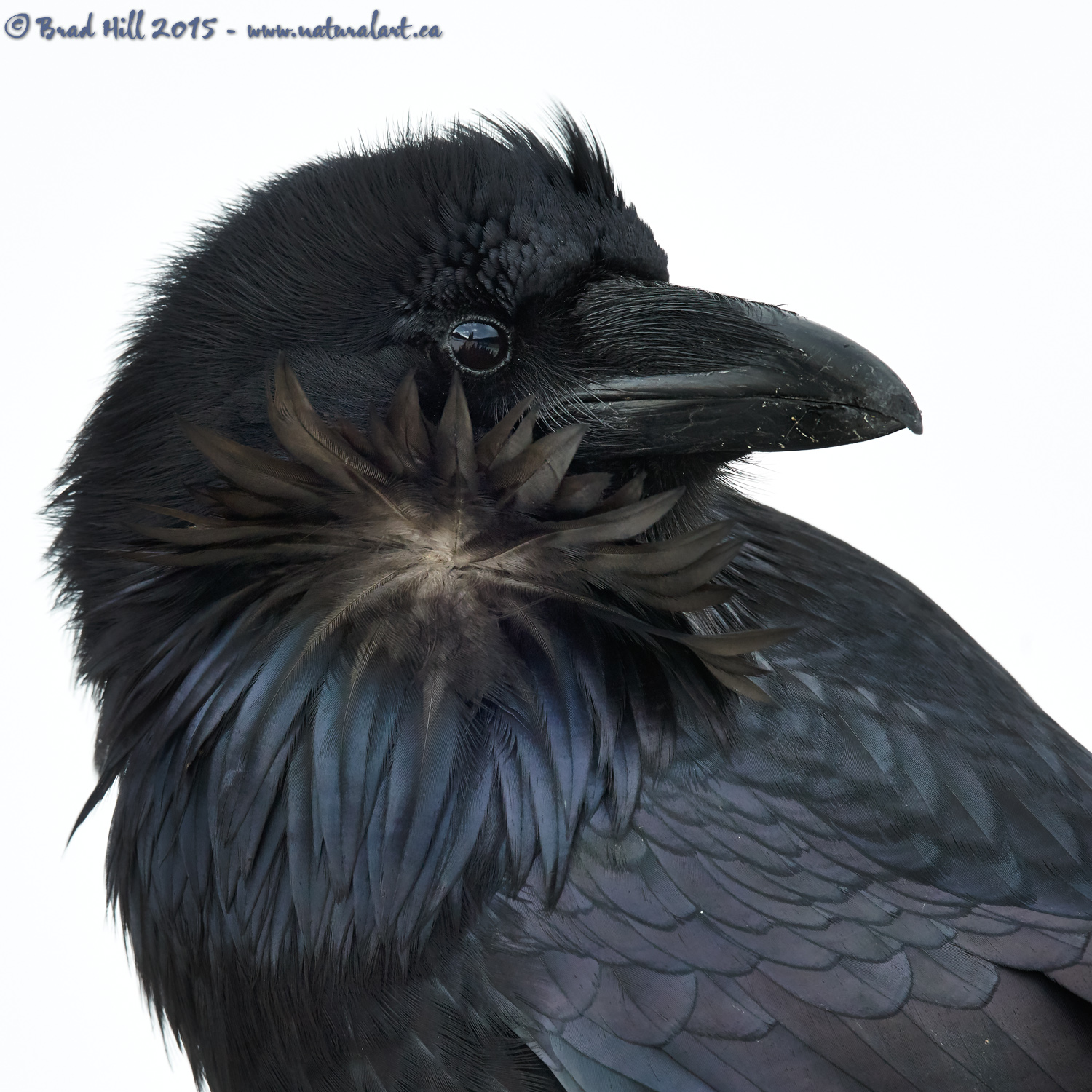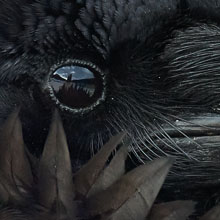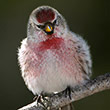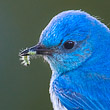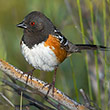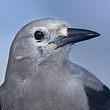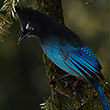Availability: Undetermined - Enquiries?
In the Field
A Puff of Wind. Numa Falls, Kootenay National Park, BC, Canada. March 6, 2015.
One of the great things about wildlife photography is that virtually ANY species can prove to be a great subject. Even the most common species do interesting things - and there's always a new or different way to capture them. The Common Raven (Corvus corax) is a great example of a common and widespread species that many overlook, but if you take the time to look at them closely they are spectacularly beautiful. At a distance they appear to be almost flat black, but if you are in a place where they allow close approach, you'll notice that while parts of them appear black (regardless of the light), many of their feathers are iridescent and reflect a huge range of colors - from green-blue through to violet-purple and more. Just as I was "lining up" this raven portrait there was a brief puff of wind, giving me (and my camera) a brief, simultaneous view of both the brown under-surface and the blue-purple outer-surface of some of the long neck feathers. And that brief puff of wind allowed me to capture an image of a raven that's just a little different from your typical raven photo (which is something I am ALWAYS watching for).
Besides their nuanced "outer" beauty, ravens are just as impressive if you watch their amazingly diverse behaviour. Among the smartest of birds, they have been known to form associations with other species, including wolves. It's thought that ravens and wolves benefit from interacting with one another in a unique way: Ravens will - on occasion - lead wolves to prey and, in turn, benefit from scavenging on the carcasses left behind by the wolves. A good win-win association for wolves and ravens! And, ravens are one of only four known animals (the others being ants, bees, and humans) with the ability of displacement, i.e., they can communicate about objects or events that are distant in space and/or time from the act of communication (an example being one raven finding a carcass and then returning to the roost to communicate the location of the find to the other ravens at the roost, often after a considerable time delay, which has been documented).
I captured this shot using a Nikon D800e paired with a Nikkor 400mm f2.8E VR lens. Because the raven was very close (approaching the near focus limit of the lens) I knew that I could (and needed to) stop down my aperture quite dramatically to ensure my depth of field (DoF) to included all the key parts of the raven that were in the frame. Because of the near proximity of the bird, and the relatively LONGER distance to the background, I was able to shoot this image at f10 and still completely isolate the subject from the background (even at f16 or f22 the background would have been COMPLETELY featureless). While almost everyone tends to think "aperture first" when it comes to controlling DoF, a bigger determinant - and the key thing to keep in mind when trying to isolate your subject from the background - are two relative distances: the distance from YOU to your SUBJECT, and the distance from the SUBJECT to the BACKGROUND. If you can keep the distance from subject to background greater than the distance between you and the subject, you'll always have a good chance of making your subject appear MUCH sharper (and eye-catching) than the background is.
There's some pretty scrumptious detail in this shot, which is best seen in a higher resolution version of it. So here's a 2400 pixel detail for your perusal:
• A Puff of Wind: Download 2400 pixel image (JPEG: 1.8 MB)
NOTES:
1. This image - in all resolutions - is protected by copyright. I'm fine with personal uses of them (including use as desktop backgrounds or screensavers on your own computer), but unauthorized commercial use of the image is prohibited by law. Thanks in advance for respecting my copyright!
2. Like all wildlife images on this website, the subject is fully wild and completely unconstrained. Besides the potential impact of my presence, nothing has been done to intentionally alter or affect the ongoing behavior of the subject and, of course, there has been no use of any form of bait or other form of wildlife attractants (including vocalizations).
Behind the Camera
A Puff of Wind. Numa Falls, Kootenay National Park, BC, Canada. March 6, 2015.
Digital Capture; Compressed RAW (NEF) 14-bit format; ISO 800.
Nikon D800e paired with Nikkor AF-S 400mm f2.8E VR - hand-held. VR on in Normal mode.
1/320s @ f10; no compensation from "recommended" matrix-metered exposure setting.
At the Computer
A Puff of Wind. Numa Falls, Kootenay National Park, BC, Canada. March 6, 2015.
RAW Conversion to 16-bit TIFF Phase One's Capture One Pro 8. Single raw conversion to 16-bit TIFF file. Adjustments during raw conversion included only a slight recovery of shadow detail (only 7 of 100 "units") and addition of a small amount of clarity (using the Clarity>Punch algorithm).
Further digital corrections on resulting 16-bit TIFF files using Adobe's Photoshop CC 2014 and Light Crafts Lightzone. Photoshop adjustments included a small image rotation, some very selective tweaks to contrast (using two consecutive Curves adjustment layers), selective colour DE-saturation, and selective sharpening for web output. Final tone-tweaking performed using LightZone's "tonemapper" tool.
Conservation
A Puff of Wind. Numa Falls, Kootenay National Park, BC, Canada. March 6, 2015.
Ten percent of the revenue generated by this image will be donated to Raincoast*.
Species Status in Canada**: This species is not designated as at risk.
The majestic Common Raven (Corvus corax) has an extremely broad geographic and ecological distribution - its natural distribution is one of the widest in the world. One factor contributing to this wide distribution is the huge range of foods (and feeding behaviour) of the raven - it's a scavenger, predator AND kleptoparasite. Its diet includes carrion, large numbers of arthropods, small rodents, bird nestlings, seeds, grains and more.
Ravens are considered to be among the most intelligent of birds and exhibit extreme behavioural plasticity. They will quickly learn innovative new methods to access food and even will form associations with other species (such as wolves) in order to obtain food. Some have even suggested that ravens will lead wolves to prey they have spotted from overhead, presumably so they can feed off the carcasses if the wolves make a successful kill (and once the wolves have had their fill).
*The Raincoast Conservation Society (and Foundation) is an effective and efficient organization that has been fighting for protection of unique habitats and species found in the province of British Columbia. If you are looking for a meaningful way to contribute to the conservation of BC's spectacular wilderness, Raincoast will provide maximal "bang" for your conservation dollars.
**as determined by COSEWIC: The Committee on the Status of Endangered Wildlife in Canada













